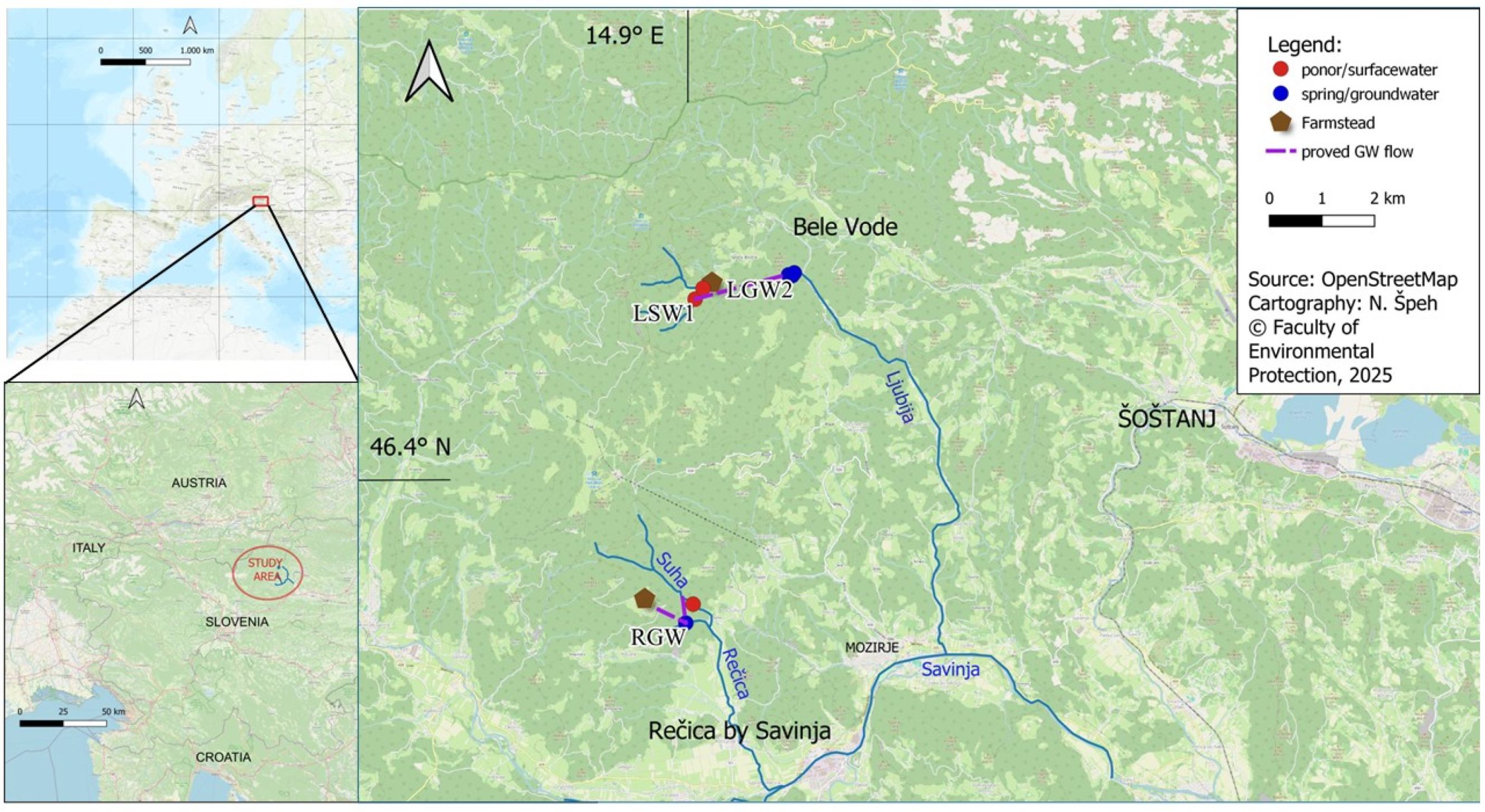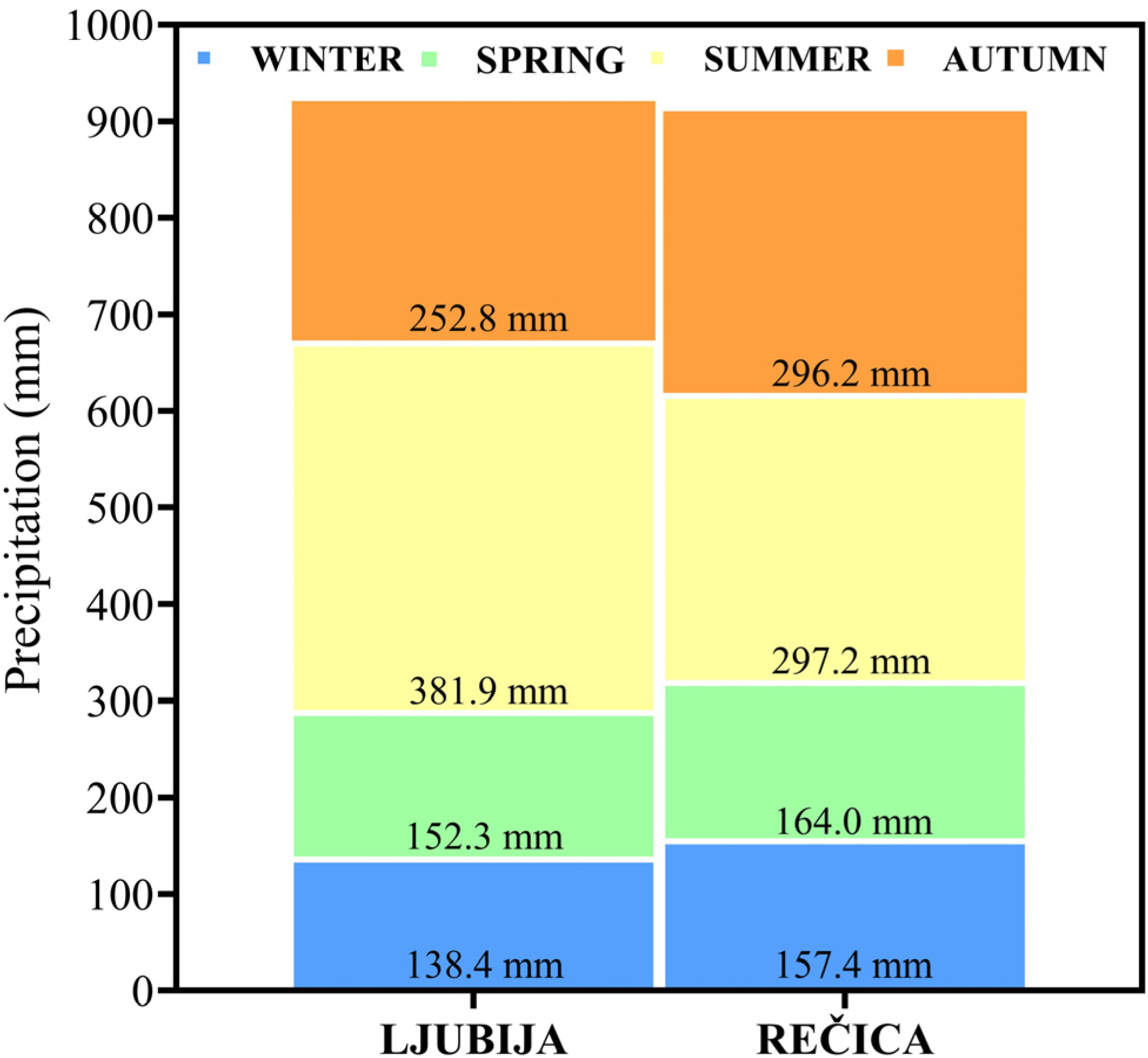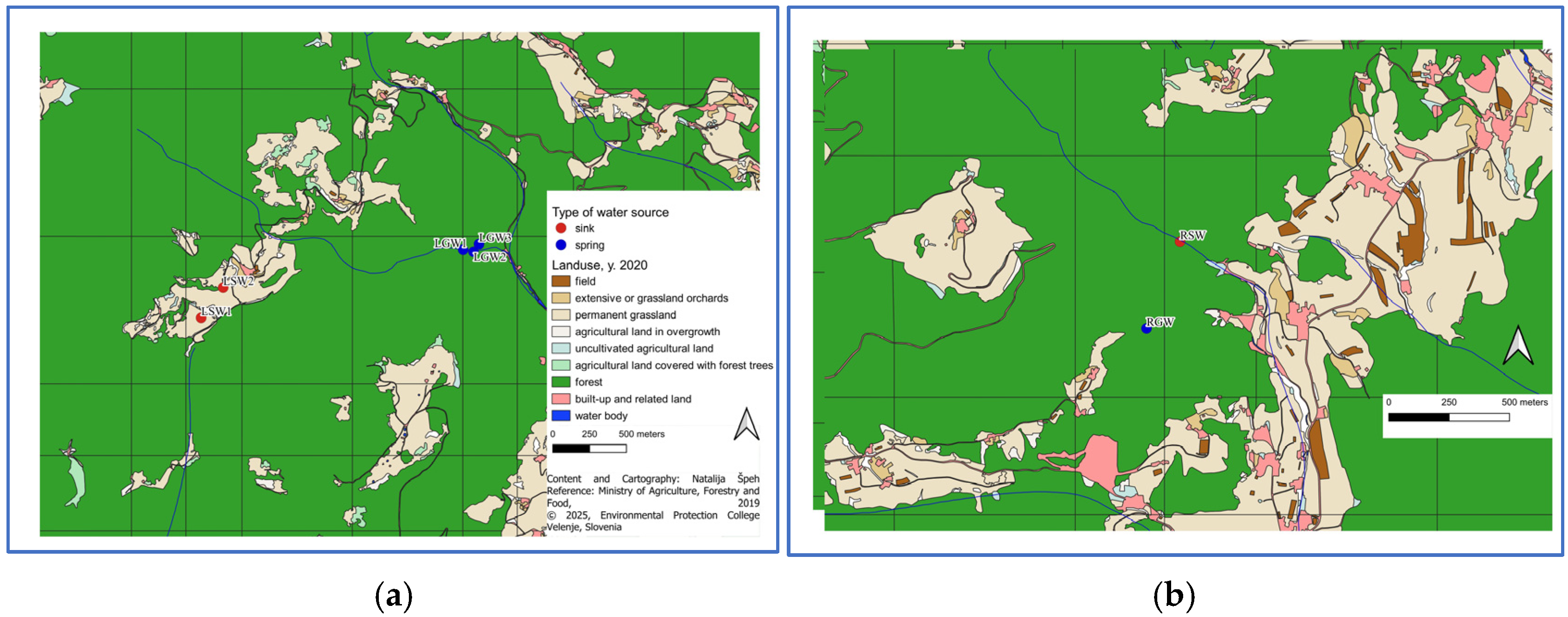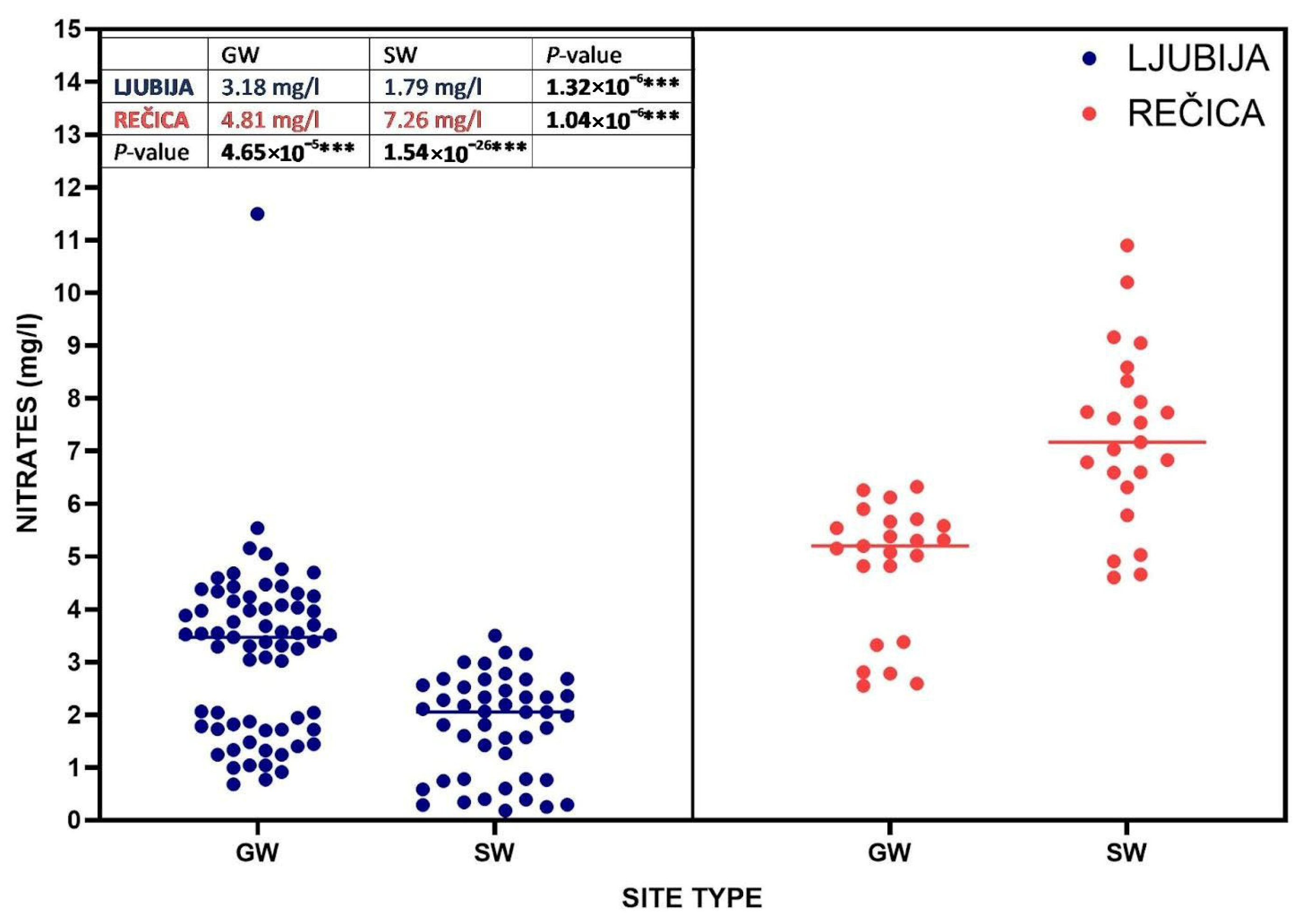An Interdisciplinary Perspective of the Karst Springs’ Areas as Drinking Water: Perusal from Northeastern Slovenia
Abstract
1. Introduction
2. Materials and Methods
2.1. Environmental Conditions in Study Areas
2.2. Sampling and Analysis
2.2.1. Meteorological Data
2.2.2. Water Sampling and Monitoring
2.2.3. Data Analysis
3. Results and Discussion
3.1. Precipitation Characteristics
3.2. Water Ecological Monitoring
3.3. Seasonal Dynamics of Selected Indicators
4. Comparison of Two Karst Catchments (WPAs)
- (a)
- Temperature data: Throughout the year, temperature data exhibited minimal fluctuations, attesting to the stability of the hydrological conditions irrespective of the precipitation events and season of the year.
- (b)
- pH values: The pH values consistently aligned with the natural background, affirming their appropriateness within the ecological context.
5. Recommendations and Proposals
6. Conclusions
- The analytical outcomes unearthed intricate connections between environmental variables and various water ecological indicators, notably including precipitation, temperature, pH value, water hardness, electrical conductivity (EC), turbidity, and nitrates. Three indicators—pH, turbidity, and electrical conductivity—adhered to the stipulations outlined in the drinking water regulations [36]. As anticipated, electrical conductivity demonstrated a proportional increase in tandem with the total hardness of the water. The monitoring data on water hardness revealed that the ponors (LSW1 and LSW2) exhibited very soft water (<4 °d), while the springs recorded a medium hardness range (6–8 °d) due to natural chemical processes, including corrosion. Furthermore, in the Rečica catchment, the average water hardness of groundwater (GW) exceeded even more than that of surface water (SW), measuring 11.5 °d and 10.1 °d, respectively.
- In the Ljubija catchment, a downstream increase in nitrate concentrations was observed, aligning with the expected pattern. Notably, the variables of hardness and nitrate concentration, while independent of each other, both exhibited an increase downstream, reflecting the influence of groundwater undersurface flow dynamics.
- Comparative analysis reveals that, on average, nitrates values for Rečica water sources surpassed those of Ljubija samples; Ljubija catchment’s average was 1.8 mg/L for SW and 3.2 mg/L in GW samples, and Rečica area’s average measurements were 7.3 mg/L for surface water (SW) and 4.8 mg/L for groundwater (GW).
Author Contributions
Funding
Data Availability Statement
Conflicts of Interest
References
- Zwahlen, F. Vulnerability and Risk Mapping for the Protection of Carbonate (Karstic) Aquifers. Final Report COST Action 620; European Commission, Directorate-General for Research: Brüssel, Luxemburg, 2004; Available online: https://libra.unine.ch/handle/123456789/14179 (accessed on 20 July 2023).
- Worthington, S.R.H. Management of Carbonate Aquifers. In Karst Management; Van Beynen, P.E., Ed.; Springer: New York, NY, USA, 2011; pp. 252–253. [Google Scholar]
- Bonacci, O.; Patekar, M.; Pola, M.; Roje-Bonacci, T. Analyses of Climate Variations at Four Meteorological Stations on Remote Islands in the Croatian Part of the Adriatic Sea. Atmosphere 2020, 11, 1044. [Google Scholar] [CrossRef]
- Bakalowicz, M. Karst groundwater: A challenge for new resources. Hydrogeol. J. 2005, 13, 148–160. [Google Scholar] [CrossRef]
- Worthington, S.R.H. Diagnostic hydrogeologic characteristics of a karst aquifer (Kentucky, USA). Hydrogeol. J. 2009, 17, 1665–1678. [Google Scholar] [CrossRef]
- Xiong, Y.; Liu, J.; Yuan, W.; Liu, W.; Ma, S.; Wang, Z.; Li, T.; Wang, Y.; Wu, J. Groundwater Contamination Risk Assessment Based on Groundwater Vulnerability and Pollution Loading: A Case Study of Typical Karst Areas in China. Sustainability 2022, 14, 9898. [Google Scholar] [CrossRef]
- Pan, L.; Dai, J.; Wu, Z.; Huang, L.; Wan, Z.; Han, J.; Li, Z. Spatial and Temporal Variations of Nitrogen and Phosphorus in Surface Water and Groundwater of Mudong River Watershed in Huixian Karst Wetland, Southwest China. Sustainability 2021, 13, 10740. [Google Scholar] [CrossRef]
- Drinking Water Directive (DWD) 98/83/EC. 2020/2184. Available online: https://eur-lex.europa.eu/eli/dir/2020/2184/oj (accessed on 20 July 2023).
- Water Directive (WD) 2000/60/EC. Available online: https://eur-lex.europa.eu/eli/dir/2000/60/oj (accessed on 20 July 2023).
- Groundwater Directive (GWD) 2006/118/EC. Available online: https://eur-lex.europa.eu/eli/dir/2006/118/oj (accessed on 20 July 2023).
- ARSO, Monitoring and Assessment of the State of Surface and Groundwater in Slovenia; Slovenian Environment Agency, Ministry of the Environment, Climate and Energy. 2016. Available online: https://www.gov.si/en/state-authorities/ministries/ministry-of-the-environment-climate-and-energy/ (accessed on 25 July 2023). (In Slovene)
- ARSO, Methodology of Evaluation of Ecological Status of Rivers Based on General Physic-Chemical Quality Elements; Slovenian Environment Agency, Ministry of the Environment, Climate and Energy. 2017. Available online: http://www.statika.evode.gov.si/fileadmin/direktive/WFD_P/2013/2013_I_1_2_6_TP_04.pdf (accessed on 25 July 2023). (In Slovene)
- Janža, M.; Lapanje, A.; Šram, D.; Rajver, D.; Novak, M. Research of the geological and geothermal conditions for the assessment of the shallow geothermal potential in the area of Ljubljana, Slovenia. Geologija 2017, 60, 309–327. [Google Scholar] [CrossRef]
- Bonacci, O.; Bonacci, D.; Patekar, M.; Pola, M. Increasing Trends in Air and Sea Surface Temperature in the Central Adriatic Sea (Croatia). J. Mar. Sci. Eng. 2021, 9, 358. [Google Scholar] [CrossRef]
- Hartmann, A.; Goldscheider, N.; Wagener, T.; Lange, J.; Weiler, M. Karst water resources in a changing world: Review of hydrological modeling approaches. Rev. Geophys. 2014, 52, 218–242. [Google Scholar] [CrossRef]
- Stevanović, Z. Managing Karst aquifers—Conceptualizations, solutions, impacts. In Karst Aquifers—Characterization and Engineering; Stevanović, Z., Ed.; Springer International Publishing: Cham, Switzerland, 2015; pp. 403–419. [Google Scholar]
- Ravbar, N.; Petrič, M.; Blatnik, M.; Švara, A. A multi-methodological approach to create improved indicators for the adequate karst water source protection. Ecol. Ind. 2021, 126, 107693. [Google Scholar] [CrossRef]
- Farzin, M.; Asadi, A.; Pukanska, K.; Zelenakova, M. An Assessment on the Safety of Drinking Water Resources in Yasouj, Iran. Sustainability 2022, 14, 3619. [Google Scholar] [CrossRef]
- Petrič, M.; Ravbar, N. Kraški vodni viri in njihovo varovanje. In Kras [Trajnostni Razvoj Kraške Pokrajine]; Luthar, O., Ed.; ZRC Publishing House: Ljubljana, Slovenia, 2008; pp. 81–84. (In Slovene) [Google Scholar]
- Petrič, M.; Kogovšek, J.; Ravbar, N. Adjustment of the Slovene legislation to the special characteristics of karst aquifers. In Karstology and Development Challenges on Karst, 1—Water; Knez, M., Petrič, M., Slabe, T., Eds.; Karst Research Institute at ZRC SAZU: Postojna, Slovenia, 2011; pp. 124–136. [Google Scholar]
- Živanović, V. Delineation of Karst groundwater protection zones. In Karst Aquifers—Characterization and Engineering; Stevanović, Z., Ed.; Springer International Publishing: Cham, Switzerland, 2015; pp. 625–642. [Google Scholar]
- ARSO, Climatological Data Archive; Slovenian Environment Agency, Ministry of the Environment, Climate and Energy. 2022. Available online: https://meteo.arso.gov.si/met/sl/archive/ (accessed on 14 July 2023).
- Slovene Cave Registry. 2020. Available online: https://www.katasterjam.si/Home/DetailedCaveMap (accessed on 20 October 2023).
- Kralj, P. Zeoliti v vulkanoklastičnih kamninah smrekovškega podgorja (severna Slovenija). Geologija 1997, 40, 247–281. [Google Scholar] [CrossRef]
- Melik, A. Slovene Alpine Region; Slovenska Matica: Ljubljana, Slovenia, 1954. (In Slovene) [Google Scholar]
- Gams, I. Karst in Slovenia in Space and Time; Scientific Research Centre of the Slovene Academy of Science and Art: Ljubljana, Slovenia, 2003; p. 510. (In Slovene) [Google Scholar]
- Špeh, N.; Bubik, A.; Barborič, B. Water-ecological conditions in Zaloka Valley. Geog. Bull. 2021, 93, 57–71. [Google Scholar]
- Municipal Company Velenje, Drinking Water Supply. Available online: https://www.kp-velenje.si/images/vsebina/Vodooskrba.pdf (accessed on 25 June 2023). (In Slovene).
- Novak, D. Hidrogeološke raziskave v zaledju izvira Župnekovo žrelo. Var. Nar. 2002, 19, 151–153. (In Slovene) [Google Scholar]
- Špeh, N.; Bubik, A.; Barborič, B. Quality of water sources and land use in the Ljubija Water Protection Area. In Regional Development Yesterday, Today, Tomorrow, 1st ed.; Nared, J., Polajnar Horvat, K., Razpotnik Visković, N., Eds.; ZRC Publishing House: Ljubljana, Slovenia, 2021; pp. 147–161. Available online: https://omp.zrc-sazu.si/zalozba/catalog/view/1974/8135/1519-2 (accessed on 20 October 2023). (In Slovene)
- Krajnc, A. 1979: Kras v povirju Ljubije. Geog. Bull. 1979, Ll, 31–42. Available online: https://zgs.zrc-sazu.si/Portals/8/Geografski_vestnik/2_Pred1999/GV_5101_031_042.pdf (accessed on 25 June 2023). (In Slovene).
- Petrič, M.; Kogovšek, J. Water temperature as a natural tracer—A case study of the Malenščica karst spring (SW Slovenia). Geol. Croatica 2010, 63, 171–177. [Google Scholar] [CrossRef]
- Ravbar, N.; Engelhardt, I.; Goldscheider, N. Anomalous behavior of specific electrical conductivity at a karst spring induced by variable catchment boundaries: The case of the Podstenjšek spring, Slovenia. Hydrol. Process. 2011, 25, 2130–2140. [Google Scholar] [CrossRef]
- Devetak, I.; Zupanc, N.; Vinko, L.; Slapničar, M. Določanje Trdote Vode: Zbirka Eksperimentov/Determination of Water Hardness—A Collection of Experiments; Faculty of Education, University of Ljubljana: Ljubljana, Slovenia, 2019. [Google Scholar]
- Ogrin, D. Podnebni tipi v Sloveniji/The climate types in Slovenia. Geog. Bull. 1996, 68, 39–55. [Google Scholar]
- Decree on Drinking Water; Official Gazette of the Republic of Slovenia. 2023. Nos. 61/23. Available online: https://www.uradni-list.si/glasilo-uradni-list-rs/vsebina/2023-01-1848/uredba-o-pitni-vodi (accessed on 5 September 2024). (In Slovene).
- Nitrati v Podzemni Vodi (in Slovene)/Nitrates in the Groundwater. Available online: https://kazalci.arso.gov.si/en/content/nitrates-groundwater-9 (accessed on 5 September 2024).







| Area | Sampling Site | Site Description | Altitude (in m) a.s.l. | Coordinates (GKX, GKY) |
|---|---|---|---|---|
| Ljubija catchment | LGW1 | left side of the Ljubija riverbed | 720 | 140,402 495,247 |
| LGW2 | right side of Ljubija | 670 | 140,410 495,256 | |
| LGW3 | Ljubija spring | 669 | 140,387 495,161 | |
| LSW1 | sink in the Rupa cave | 929 | 139,959 493,354 | |
| LSW2 | sink below the organic farm | 910 | 140,201 493,568 | |
| Rečica catchment | RGW1 | spring in Žegnan Studenec | 429 | 133,349 493,746 |
| RSW1 | sink Suha | 465 | 133,630 493,700 |
| Area | Sampling Site | Site Type | Twater (°C) | pH | Turbidity (NTU) | EC (µS/cm) | Hardness (°d) | Nitrates (mg/L) |
|---|---|---|---|---|---|---|---|---|
| Ljubija catchment | LGW1 | groundwater | 8.3 ± 2.4 | 7.5 ± 0.6 | 8.8 ± 6.3 | 272.1 ± 46.7 | 6.7 ± 1.0 | 3.2 ± 2.3 |
| LGW2 | groundwater | 7.8 ± 2.5 | 7.5 ± 0.5 | 8.6 ± 7.7 | 262.9 ± 48.0 | 6.9 ± 0.8 | 3.0 ± 1.2 | |
| LGW3 | groundwater | 7.6 ± 2.2 | 7.4 ± 0.5 | 9.2 ± 5.4 | 246.0 ± 61.1 | 6.2 ± 0.5 | 3.3 ± 1.4 | |
| LGW average | groundwater | 7.9 ± 2.3 | 7.5 ± 0.5 | 8.9 ± 6.5 | 260.0 ± 52.8 | 6.7 ± 0.8 | 3.2 ± 1.7 | |
| LSW1 | surface water | 8.4 ± 5.7 | 7.4 ± 0.4 | 11.5 ± 8.2 | 172.1 ± 40.1 | 3.8 ± 0.8 | 1.9 ± 0.9 | |
| LSW2 | surface water | 7.9 ± 5.3 | 7.4 ± 0.6 | 9.0 ± 5.4 | 102.4 ± 31.5 | 2.3 ± 0.6 | 1.7 ± 0.9 | |
| LSW average | surface water | 8.1 ± 5.5 | 7.4 ± 0.5 | 10.2 ± 7.0 | 137.2 ± 50.1 | 3.1 ± 1.1 | 1.8 ± 0.9 | |
| AVERAGE | 8.0 ± 3.9 | 7.4 ± 0.5 | 9.4 ± 6.7 | 210.0 ± 79.5 | 5.2 ± 2.0 | 2.6 ± 1.6 | ||
| Rečica catchment | RGW1 | groundwater | 9.3 ± 1.8 | 7.8 ± 0.4 | 13.4 ± 7.7 | 417.0 ± 95.5 | 11.5 ± 0.4 | 4.8 ± 1.2 |
| RSW1 | surface water | 8.7 ± 3.9 | 7.8 ± 0.6 | 9.9 ± 7.2 | 377.3 ± 88.2 | 10.1 ± 0.6 | 7.3 ± 1.7 | |
| AVERAGE | 9.0 ± 3.1 | 7.8 ± 0.5 | 11.7 ± 7.6 | 397.2 ± 93.1 | 10.8 ± 0.9 | 6.0 ± 1.9 | ||
| Type of parameter * | physical | chemical | indicator | indicator | physical | chemical | ||
| 2019 | 2020 | 2021 | Measured Data | |
|---|---|---|---|---|
| Twater (°C) | 7.4 | 7.0 | 7.2 | 7.6 |
| pH | 8.3 | 8.2 | 8.2 | 7.4 |
| turbidity (NTU) | 2.7 | 2.0 | 2.0 | 9.2 |
| EC (µS/cm) | 224.1 | 299.6 | 214.2 | 246.0 |
| hardness (°d) | 6.2 | 6.7 | 6.1 | 6.2 |
| nitrates (mg/L) | 3.4 | 3.4 | 3.3 | 3.3 |
Disclaimer/Publisher’s Note: The statements, opinions and data contained in all publications are solely those of the individual author(s) and contributor(s) and not of MDPI and/or the editor(s). MDPI and/or the editor(s) disclaim responsibility for any injury to people or property resulting from any ideas, methods, instructions or products referred to in the content. |
© 2025 by the authors. Licensee MDPI, Basel, Switzerland. This article is an open access article distributed under the terms and conditions of the Creative Commons Attribution (CC BY) license (https://creativecommons.org/licenses/by/4.0/).
Share and Cite
Špeh, N.; Bubik, A. An Interdisciplinary Perspective of the Karst Springs’ Areas as Drinking Water: Perusal from Northeastern Slovenia. Pollutants 2025, 5, 19. https://doi.org/10.3390/pollutants5030019
Špeh N, Bubik A. An Interdisciplinary Perspective of the Karst Springs’ Areas as Drinking Water: Perusal from Northeastern Slovenia. Pollutants. 2025; 5(3):19. https://doi.org/10.3390/pollutants5030019
Chicago/Turabian StyleŠpeh, Natalija, and Anja Bubik. 2025. "An Interdisciplinary Perspective of the Karst Springs’ Areas as Drinking Water: Perusal from Northeastern Slovenia" Pollutants 5, no. 3: 19. https://doi.org/10.3390/pollutants5030019
APA StyleŠpeh, N., & Bubik, A. (2025). An Interdisciplinary Perspective of the Karst Springs’ Areas as Drinking Water: Perusal from Northeastern Slovenia. Pollutants, 5(3), 19. https://doi.org/10.3390/pollutants5030019







